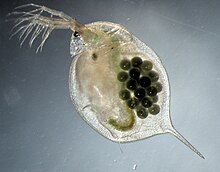| Daphnia magna | |
|---|---|
 | |
| Female Daphnia magna with a clutch of asexual eggs: The animal is about 4 mm long. | |
| Scientific classification | |
| Kingdom: | |
| Phylum: | |
| Subphylum: | |
| Class: | |
| Order: | |
| Family: | |
| Genus: | |
| Species: | D. magna |
| Binomial name | |
| Daphnia magna Straus, 1820 [1] | |
Daphnia magna is a small planktonic crustacean (adult length 1.5–5.0 mm) that belongs to the subclass Phyllopoda. It inhabits a variety of freshwater environments, ranging from acidic swamps to rivers made of snow runoff, and is broadly distributed throughout the Northern Hemisphere and South Africa.[2]
The species has been subject of biological research since the 18th century.[3] It is widely used in ecological and evolutionary studies, and in ecotoxicology.[4] It is a popular fish food in aquaculture and aquaria.
D. magna is widespread in the Northern Hemisphere and in particular in the holarctic.[5] It can be found in freshand brackish water bodies of different sizes, from lakes to ponds and ephemeral rock pools near the sea. D. magna tolerates higher levels of salinity (up to one-fifth the salinity of sea water) than most other species of the genus.[6] D. magna is mainly found in the pelagic zone of water bodies, as it feeds primarily on suspended particles in the water column (mainly algae, but also bacteria and detritus). Nevertheless, compared to other species of Daphnia, it is more often found in association with the substrate where it is able to exploit benthic foodsources as periphyton[13] and sediment.[7]
Nutrition[edit]
The main feeding strategy of D. magna is the filtering of suspended particles.[7] A specialized filtering apparatus, formed by the thoracic appendices, generates a water current within the thoracic opening of the carapace, which permits the collection and the ingestion of unicellular algae, bacteria, and detritus. D. magna can also feed on periphyton[13] and detritus,[7] an ability that can offer a competitive advantage to this species over strictly pelagic filter feeders in some environments where suspended food sources might be temporally limited.
As most of the other species of the genus Daphnia, D. magna reproduces by cyclical parthenogenesis. This form of reproduction is characterised by the alternating production of asexual offspring (clonal reproduction) and at certain time sexual reproduction through haploid eggs that need to be fertilised.
The asexual eggs (up to few dozens per clutch) are diploid and usually develop into females, or in response to adverse environmental stimuli, into males.
Asexual eggs hatch in the female brood pouch 1 day after being laid and are released after 3 days. Juveniles go through four to about six moults before becoming mature over a period of 5–10 days. An adult female produces one clutch with up to 100 eggs every 3–4 days until her death. It can live over 3 months in the laboratory at 20 °C.[14]
In response to unfavourable environmental conditions (which could lead to the freezing or the drying up of the pond), the same female can produce haploid resting eggs (usually two at a time), which when fertilised by males, are wrapped within a protective shell called an ephippium. These resting eggs enter a phase of diapause and are able to resist long periods of adverse environmental conditions over a long period of time. Hatching is triggered in response to specific stimuli such as increasing photoperiod and temperatures. The hatchlings from resting eggs develop exclusively into females.
Some clones of D. magna that do not produce males reproduce by automictic parthenogenesis, in which two haploid cells produced by meiosis fuse to produce a female zygote without fertilisation. This tends to make the resulting daughters homozygous, which may be deleterious.[15]
D. magna has become a model system to study the evolution and ecology of host-parasite interaction.[6] Animals collected from natural habitats are frequently infected.[18] Many parasites that infect D. magna have been identified and studied (Table 1), D. magna shows parasite-induced behavioural characteristics that can differ among genotypes.[19]
| Taxa | Parasite | Tissue or infection site | Transmission |
| Bacteria | Pasteuria ramosa | Blood, extracellular | Horizontal, from dead host |
| Spirobacillus cienkowskii | Blood, extracellular | Horizontal, from dead host | |
| Fungi | Metschnikowia bicuspidata | Body cavity, extracellular | Horizontal, from dead host |
| Microsporidia | Hamiltosporidium tvärminnensis | Intracellular | Horizontal and vertical |
| H. magnivora | Intracellular | Vertical, Horizontal (?) | |
| Glucoides intestinalis | Gut wall, intracellular | Horizontal, from living host | |
| Ordospora colligata | Gut wall, intracellular | Horizontal, from living host | |
| Amoeba | Pansporella perplexa | Gut wall, extracellular | Horizontal, from living host |
| Chytrid fungus | Caullerya mesnili | Gut wall, intracellular | Horizontal, from living host |
| Nematoda | Echinuria uncinata | Body cavity, extracellular | Horizontal, to a second host |
| Cestoda | Cysticercus mirabilis | Body cavity, extracellular | Horizontal, to a second host |
https://en.wikipedia.org/wiki/Daphnia_magna
aziv free
https://en.wikipedia.org/wiki/Spirobacillus_cienkowskii
https://en.wikipedia.org/wiki/Hamiltosporidium
https://en.wikipedia.org/wiki/Pasteuria_ramosa
https://en.wikipedia.org/wiki/Hamiltosporidium
https://en.wikipedia.org/wiki/Ordospora_colligata
https://en.wikipedia.org/wiki/Ephippia
above. the pussycat dolls buttons






No comments:
Post a Comment